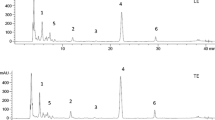Abstract
Sixteen sugarcane varieties varying from light to dark rind color were evaluated for various pigments viz., chlorophyll, carotenoids, xanthophylls and anthocyanins. Phenols, amino acids and reducing sugars in juice which contribute to the color of the juice and some technological juice process related parameters were also estimated. Significant differences among varieties were found for pigments, juice colorants and technological juice process related parameters. The dark colored varieties were found to contain higher amount of anthocyanins than that of light colored varieties. The variety Co 8209 had significantly higher content of amino acids in juice and may result in juice process related problems. Higher optical density (OD) values of raw juice were obtained from the varieties Co 94008, CoV 92102, Co 86032 and ISH 69 due to the presence of higher quantities of anthocyanins. The magnitude of drop in the OD values of juice after clarification was less in the varieties Co 62198 and Co 86011. Correlation studies between various pigments, juice colorants and juice process related technological parameters indicated that total carotenoids positively associated with the juice mud volume. Anthocyanins positively influenced the percent impurities in juice as indicated by lead number. Higher content of phenols in cane juice was found to increase the color of the raw juice and settling time. The findings of the present study indicated that some of the juice process related parameters like claribility, settling time and mud volume are not only influenced by the pigments from rind of the cane and colorants in juice but are independent of the sucrose content of the juice.
Similar content being viewed by others
References
Bento LSM (2003) Technological color control of sugar products. International Sugar Journal 105:425–433.
Bray GG, Thorpe WV (1954) Analysis of phenolic compounds of interest in metabolism. Methods Biochem Anal 1:27–52.
Chen JCP, Chou CC (1993) Cane Sugar Handbook. 12th ed John Wiley & Sons. New York.
Chiranjivi Rao K, Asokan S (1974) Alkaline potassium ferricyanide method (colorimetric) for the determination of reducing sugars in cane juice. India Sug 23:951–954.
Chiranjivi Rao K, Lalitha E, Thangavelu S (1972) Need for screening sugarcane genotypes for their milling and manufacturing characteristics. Diamond Jubilee Symposium of the sugarcane Breeding Institute, Coimbatore.
Dieter F, Metcalfe DL, Park J (1987) A new sugar decolorization process. Int Sugar J 89:46–54.
Gomez KA, Gomez AA (1984) Statistical Procedure for Agricultural Research. A Wiley Interstice, John Wiley and Sons, Singapore.
Guillen VR, Solis FJA, Duran de Bazua MC (2002) Color removal in sugarcane juice using DEAE bagasse: A surface response analysis. Int. Sugar J. 104:97–107.
Singh K, Buttar GS (2002) Effect of cane wax on cane juice settling, turbidity and ICUMSA color. Cooperative Sugar 34:193–195.
Linonet GRE (1992) Sixty seventh review of the milling season in Southern Africa (1991–1992). Proc. South African Sugar Technology Association 66:1–20.
Meade GP, Chen JCP (1977) Cane Sugar Handbook. John Wiley and Sons, New York.
Moore S, Stein WH (1948). Determination of total amino acids in sugarcane juice. J Bio Chem 176(8): 367–369.
Paton NH (1992) The origin of color in raw sugar. Proc Australia Sugar Cane Technol 14:8–17.
Sens V, Decagny G (2001) Comparing cane varieties for some factors that affect sugar processing. Proc Int Soc Sugarcane Tech 24: 66–73.
Sharma SC, Johary PC (1978) Some observations on the chemical composition of the cane juices of different promising varieties grown in North Bihar conditions and their clarification characteristics. Sugar Tech Assn India 42: M 19–32.
Sharma KP, Kanwar RS (1985) Effect of micronutrients on some biochemical activities of a high sucrose variety of sugarcane grown in calcareous sandy soil. Trop Agric 62: 334–338.
Shukla SP, Gupta AP (1976) Proc Sugar Tech Association 41: Ag 37–46.
Smith IA (1990) A survey of color imput and formation in process. Proc South African Sugar Technol Assoc 64: 213–216.
Smith P, Paton NH (1985) Sugarcane flavonoids. Sugar Technol Rev 12:117–142.
Srinivas Iyer KK (2007) Evaluation of certain varieties of sugarcane for pigments and antioxidants. Dissertation submitted in partial fulfillment of the requirement for the degree of Master of Science (Applied Chemistry), Sugarcane Breeding Institute, Coimbatore.
Thuljaram Rao JTK, Rao C, Narasimhan R (1967) Proc South Indian Sugars Technol Assoc 29–34.
Weybrew JA (1957) Estimation of plastid pigments of tobacco. Tobacco Science 1:1–5.
Wrolstad RE, Giusti MM, Rodriguez S (1999) Molar absorptivity and color characteristics of acylated and non acylated pelargonidin based anthocyanins. J Agric and Food Chemistry 47:4631–4637.
Author information
Authors and Affiliations
Corresponding author
Rights and permissions
About this article
Cite this article
Rupa, T.R., Asokan, S. Effect of rind pigments and juice colorants on juice claribility, settling time and mud volume of sugarcane. Sugar Tech 10, 109–113 (2008). https://doi.org/10.1007/s12355-008-0018-9
Received:
Accepted:
Published:
Issue Date:
DOI: https://doi.org/10.1007/s12355-008-0018-9




